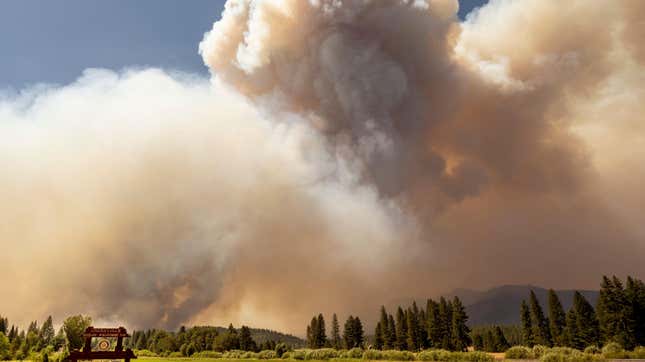
Amid a record-breaking fire season in the U.S. West, new research shows that air pollution from last year’s wildfires California, Washington, and Oregon was associated with an increased risk of contracting and dying from covid-19.
For the new study, published in Science Advances on Friday, researchers examined publicly available data on the covid-19 cases and deaths from 92 counties across the three states—covering the areas where most of the year’s wildfires occurred—over the course of 277 days in 2020. They then compared the numbers with regional public data on levels of fine particulate matter (PM2.5) in the air from the same time span.
In California’s Calaveras county, home to 45,500 people, there were 22 covid-19 deaths during the period they studied, and 77% of those deaths occurred after there had been 28 consecutive days of wildfire smoke. In Butte County, higher PM2.5 from smoke was also strongly linked to more covid-19 deaths—the authors found there were 41% more deaths than would have been expected without smoke. Other counties showed similar patterns.
To tease out how exposure to PM2.5 could have impacted covid-19 cases and deaths, the authors looked at how much of the pollution residents were exposed to in the 28 days before they received a positive test or died. In other words, if a person died of covid-19 on April 1, the researchers looked at pollution levels in the four weeks before their death.
Then, using data from the National Oceanic and Atmospheric Administration’s hazard mapping system, the researchers identified where and when residents in the data set were exposed to dangerous levels of smoke from wildfires.
“We were able to create an indicator that says, This day was a wildfire smoke day, so we know that any PM2.5 measurement measured on that day ... that is probably attributable to wildfire smoke,” Kevin Josey, a postdoctoral research fellow in biostatistics at Harvard University, explained.
But wildfires aren’t the only sources of PM2.5; infrastructure like fossil fuel plants and highways create it, too. So to see how much particulate matter in the data set was attributable to wildfire smoke, the authors compared levels of PM2.5 on wildfire days to levels on non-wildfire days, from 2016 through 2019.
“We could then ask, what would be a good expectation of what those PM2.5 measurements should have been, if there weren’t any wildfires? And we could then see how much excess pollution the smoke caused,” said Josey.
The authors found that across the 92 Western counties, there were over 700 deaths and nearly 20,000 cases more than would have been expected if increased pollution from wildfires wasn’t present.
“These numbers basically show that we saw this many more covid cases and deaths than we would have if there was no PM2.5 from wildfire smoke at all,” said Josey.
The study also suggests that PM2.5 made people more likely to contract covid-19 in some counties. Exposure to air pollution seemed to have the greatest impact on covid-19 cases in the counties of Butte, California, and Whitman, Washington. In both, the authors found that there were nearly one-fifth more covid-19 cases than would have been expected without PM2.5 from smoke.
Several previous studies have shown that exposure to dirty air can increase vulnerability to covid-19, but this is the first this is the first to provide direct estimate of the number of covid-19 cases and deaths directly attributable to wildfire pollution. Josey said the results were not shocking but still hard to stomach.
“We were not terribly surprised by the results as scientists, but as humans we are dismayed about the impacts,” he said.
Josey hopes this research will help illustrate the urgency of addressing both the existential threats of covid-19 and climate change to policymakers.
“It is clear that climate change is creating an environment in which wildfires are becoming more and more prevalent. We need long-term solutions to address this issue and others affecting air quality, otherwise we will continue seeing worse health outcomes caused by pollution,” he said. “In the short-term, we can counteract covid-19 cases and deaths by getting as many people vaccinated [as possible]. If we are protected from the disease itself, there is no way for wildfire smoke or PM2.5 to exacerbate the issue.”